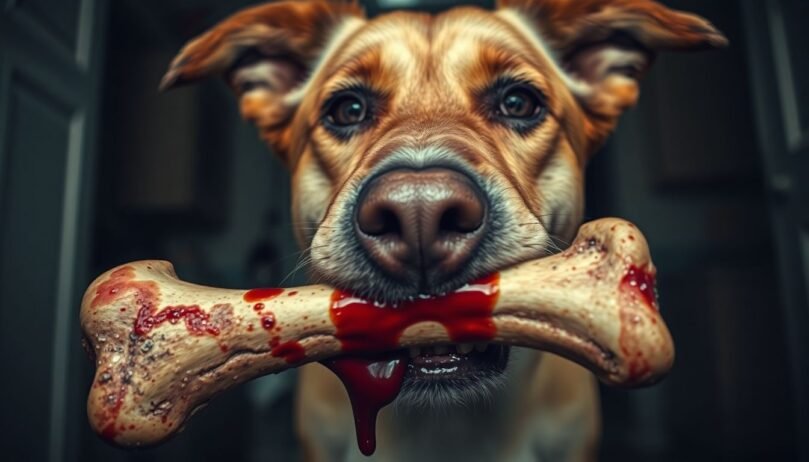Can You Feed A Dog A Bone With Blood Inside
- 24 January 2025
- BuyAPet Editorial Team
- All Dogs, Dog Health
Can Feeding Your Dog a Bloody Bone Make Them Sick? 🦴
Raw bones can be tempting—but marrow and residual blood may carry risks. Here’s what to know, safer alternatives, and when to call your vet.
The idea of giving your dog a bone is tempting. Many dogs love the taste and the mental workout of a real chew. But when it comes to bones with visible blood or marrow, there are important safety and hygiene factors to consider.
Risks of bloody bones, how to choose and handle safer options, warning signs after chewing, and healthy alternatives.
The Allure and Risks of Raw Bones 🧲⚠️
Why Owners Choose Raw Bones
- Natural chewing outlet & mental stimulation.
- Mechanical tooth-scraping action.
- Highly palatable taste and texture.
What Makes “Bloody” Bones Riskier?
Residual blood and raw marrow can harbour bacteria. Handling and storage matter just as much as what your dog chews.
Understanding the Risks of Blood in Bones 🧪
Bacterial Contamination
Raw bones may contain Salmonella or E. coli, which can make dogs—and people in the household—sick.
- Clean and disinfect surfaces after handling raw products.
- Wash hands thoroughly; use separate chopping boards.
- Keep raw items away from ready-to-eat foods.
Nutritional Imbalance
Bones are calcium-rich and can skew the calcium-phosphorus balance if overfed, potentially impacting bone and joint health over time.
- Do not rely on bones as a primary nutrient source.
- Feed within a complete, balanced diet formulated for dogs.
Mechanical & Digestive Risks
- Broken teeth from very hard/weight-bearing bones.
- Choking or esophageal obstruction from small pieces.
- Constipation or blockages from bone fragments.
- Pancreatitis risk with very fatty marrow or trimmings.
Safe-handling checklist for your kitchen 🧽
- Refrigerate raw bones in sealed containers; follow use-by dates.
- Discard leftovers that sat out >1–2 hours at room temp.
- Freezing reduces but does not eliminate bacteria; still handle as raw.
Identifying Safer Bones for Your Dog 🛡️
Choose the Right Type
- Size: The bone should be larger than your dog’s muzzle to reduce choking risk.
- Density: Avoid very hard, weight-bearing leg bones of large animals that can crack teeth.
- Texture: Meaty, cartilaginous options (e.g., some non-weight-bearing parts) are generally gentler—but still supervise.
Source & Storage
- Purchase from reputable suppliers/butchers with good cold-chain practices.
- Store chilled; serve on an easy-to-clean surface.
- Limit chewing sessions (e.g., 10–15 minutes) and discard small or splintered pieces.
Supervision Rules
- Always supervise; teach “drop”/“leave it.”
- One dog per chew to prevent gulping/guarding.
- Avoid if your dog is a vigorous gulper or has dental/GI issues—speak with your vet first.
Recognizing Signs of Illness After Bone Consumption 🚩
GI Upset
- Vomiting, diarrhoea, straining, or loss of appetite.
- Excessive drooling, restlessness, or visible discomfort.
When to Seek Veterinary Care
- Symptoms lasting >24 hours or worsening.
- Blood in stool/vomit, repeated retching, or bloated abdomen.
- Signs of pancreatitis: lethargy, hunched posture, abdominal pain.
Post-Chew Monitoring
- Offer water; withhold rich/fatty foods for the next meal if mildly queasy.
- Observe stools and behaviour for 48 hours.
- Contact your vet with any concerns or if your dog swallowed a large piece.
Alternative Safe Chews for Your Canine Companion 🐕🦺
Durable Commercial Options
- Rubber or nylon chew toys sized for your dog.
- Edible dental chews (follow label age/size guidance).
- Rope toys (supervise; discard when frayed).
Natural Snack Alternatives
- Crunchy veg like carrots or cucumber sticks.
- Apple slices (no seeds/core) or plain dehydrated sweet potato.
- Frozen lick mats with wet food or xylitol-free peanut butter.
Nutrition First
Chews are extras. Prioritise a complete, balanced diet appropriate for your dog’s life stage and health.
Conclusion: Make Informed Choices 🧠
Raw, bloody bones can offer enjoyment—but they also carry meaningful risks, from bacteria to dental and digestive problems. If you choose to offer raw bones, select safer types, handle them hygienically, and supervise closely. When in doubt, opt for safer chew alternatives.
Best next step: Talk with your veterinarian about the right chew strategy for your dog’s age, size, teeth, and medical history.
See Safer AlternativesThis guide is informational and not a substitute for professional veterinary advice. If your dog shows concerning symptoms, contact your vet promptly.
